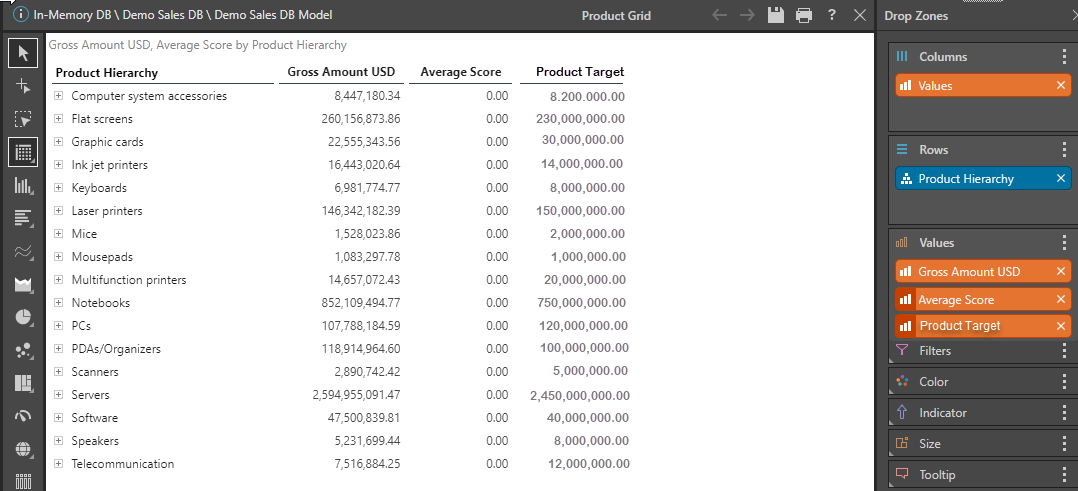2020.10 is the latest release from Pyramid Analytics. It extends the functionality introduced in our major 2020 release. This is one in a series of posts that highlights some of the major new features.
Pyramid now integrates seamlessly with Datavard’s “Glue” a third-party tool that allows users to trigger and extract raw SAP ERP data. Glue is a specialized application that can be configured to extract data from an SAP system and store the results in external destinations. Pyramid’s built-in connector to Glue provides a code-free ability to trigger a Glue extraction package—providing a less technical end-user with the ability to extract SAP data (outside of SAP BW or HANA views) with a few clicks, in an uncomplicated fashion, to drive custom data models and subsequent analysis.
The problem
SAP’s ERP system provides advanced ERP capabilities and features for end-users. However, SAP data is very inaccessible to most end users, which stymies a fully functional self-service BI approach to working with SAP data outside of SAP BW and or HANA Views. While SAP data is typically stored in a classic relational database (Oracle, MS SQL, DB2, and HANA), it’s generally unwise for analytical processes to be run directly on operational data stores—especially those underpinning SAP.
Datavard’s Glue integrates into SAP, providing a data extraction framework for SAP data— thus eliminating the dangers of working on the data directly. It also offers an SAP intelligent engine for working out what to use from where in SAP (a challenge on its own). However, Glue is designed for IT or developers—too advanced for non-technical users.
The solution
Pyramid integrates seamlessly with Glue, using point-and-click functionality to incorporate Glue’s extraction packages as a data source in Pyramid’s data flow application. All Pyramid’s extensive self-service BI functionality is then available for raw SAP data, allowing effortless creation of data mashups, reports, dashboards, publications, machine learning, et cetera.
Business case
Ron, a business analyst at GHJ Inc., uses Pyramid to perform analytics on their SAP ERP system. GHJ has also deployed Glue to perform ETL extracts from SAP. Ron would like to create queries from SAP using curated data extracts built-in Glue and then mash that together with product target information from an Excel spreadsheet and build a series of reports.
In this diagram of Pyramid’s Data Flow canvas, Ron selects data from a Glue data source that extracts two different transactional tables based on criteria from a product category listing. Glue makes it easy for him to extract the data normally locked deep in the recesses of the SAP system. He then mashes the data with an Excel spreadsheet containing annual product target amounts and a Python module to convert all international sales into USD. After dragging a Glue object onto the canvas, Ron selects the instance and extraction definition and sales tables from simple dropdowns. He then adds his Excel spreadsheet and his Python currency table, joins the data in a logical flow, and stores all data in Pyramid’s in-memory database.

Once the data flow is run (which took around 30 seconds to extract 10,000 records), Ron quickly creates a report in Pyramid’s Discover app using the mash-up of his SAP Sales data and his Excel spreadsheet of product sales targets.

Summary
SAP data is very inaccessible to most end users—which stymies a fully functional self-service BI approach to working with SAP data outside SAP BW and/or HANA Views. Pyramid integrates with Datavard’s “Glue” to enable users to trigger and extract raw SAP ERP data. The process and integration can be used by non-technical users using point-and-click data flow tools. Once processed, Pyramid brings its extensive self-service BI functionality to the SAP data extracts, allowing effortless creation of reports, dashboards, publications, machine learning, etcetera.
2020.10 new feature series:
Pyramid 2020.10 is chock full of powerful features like the content migration tools described above. For more detail about some of the other new headline features contained in the 2020.10 release, please see these additional write-ups:
- Post 1 – Calendar Slicer: The smart Calendar Slicer in Pyramid is designed to make date-time operations fast and simple for both novice and advanced users alike. It is especially useful when more date-time structures in the original data source do not exist, and users do not want to use complex formulas to filter data with dates.
- Post 2 – Ragged Queries: The ragged query feature in Pyramid helps users create highly complex views of data, allowing them to easily “laser” out content items they do not want to see in a report—effectively building an “asymmetric” query.
- Post 3 – Self-Building Data Catalogs: Pyramid provides users with a self-building and self-maintaining documentation mechanism for data and analytics. The ‘Data Catalog’ helps analysts and administrators to find the data or analytical assets that they need.
- Post 4 – Data Catalog Toolkit: Learn about Pyramid’s Structure Analyzer, Data Source Changer, and Lineage tool, all of which provide a graphical, intuitive set of mechanisms for all the elements in the system, fully exploiting the power of centralized data and asset cataloging.
- Post 5 – Flow Grids and Flow Charts: The flow grid and flow chart tools in Pyramid are designed to extend the grid and chart capability for publications dramatically.
- Post 6 – Present Lite: The new Present Lite tool is designed to create quick and easy dashboards for non-technical users. Users will experience a simplified UI with fewer advanced features, and they will get all the essential tools required for creating self-service, self-built dashboards.
- Post 7 – Audit Logs: Pyramid’s Audit Trail provides users with a framework to track all changes made to key objects throughout the system – providing administrators with a clear view and history of when an object was created, changed, or deleted, by date and by a user.
- Post 9 – Content Migration: Pyramid users can easily migrate content from one Pyramid instance to another with an easy, intuitive wizard assisting them through the process. This facilitates the re-use of content items with efficient processes to ensure governance and security.














